Early commercial instruments
 The earliest telephones had only one wire for both transmitting and receiving of audio, and used a ground return path, as was found in telegraph systems. The earliest dynamic telephones also had only one opening for sound, and the user alternately listened and spoke (rather, shouted) into the same hole. Sometimes the instruments were operated in pairs at each end, making conversation more convenient but also more expensive.
The earliest telephones had only one wire for both transmitting and receiving of audio, and used a ground return path, as was found in telegraph systems. The earliest dynamic telephones also had only one opening for sound, and the user alternately listened and spoke (rather, shouted) into the same hole. Sometimes the instruments were operated in pairs at each end, making conversation more convenient but also more expensive. Historical marker commemorating the first telephone central office in New York State (1878)
Signaling began in an appropriately primitive manner. The user alerted the other end, or the exchange operator, by whistling into the transmitter. Exchange operation soon resulted in telephones being equipped with a bell, first operated over a second wire and later with the same wire using a condenser. Telephones connected to the earliest Strowger automatic exchanges had seven wires, one for the knife switch, one for each telegraph key, one for the bell, one for the push button and two for speaking.
Rural and other telephones that were not on a common battery exchange had a "magneto" or hand cranked generator to produce a high voltage alternating signal to ring the bells of other telephones on the line and to alert the exchange operator.
In 1877 and 1878, Edison invented and developed the carbon microphone used in all telephones along with the Bell receiver until the 1980s. After protracted patent litigation, a federal court ruled in 1892 that Edison and not Emile Berliner was the inventor of the carbon microphone. The carbon microphone was also used in radio broadcasting and public address work through the 1920s.
1896 Telephone (Sweden)
Cradle designs were also used at this time, having a handle with the receiver and transmitter attached, separate from the cradle base that housed the magneto crank and other parts. They were larger than the "candlestick" and more popular.
Disadvantages of single wire operation such as crosstalk and hum from nearby AC power wires had already led to the use of twisted pairs and, for long distance telephones, four-wire circuits. Users at the beginning of the 20th century did not place long distance calls from their own telephones but made an appointment to use a special sound proofed long distance telephone booth furnished with the latest technology.

No comments:
Post a Comment